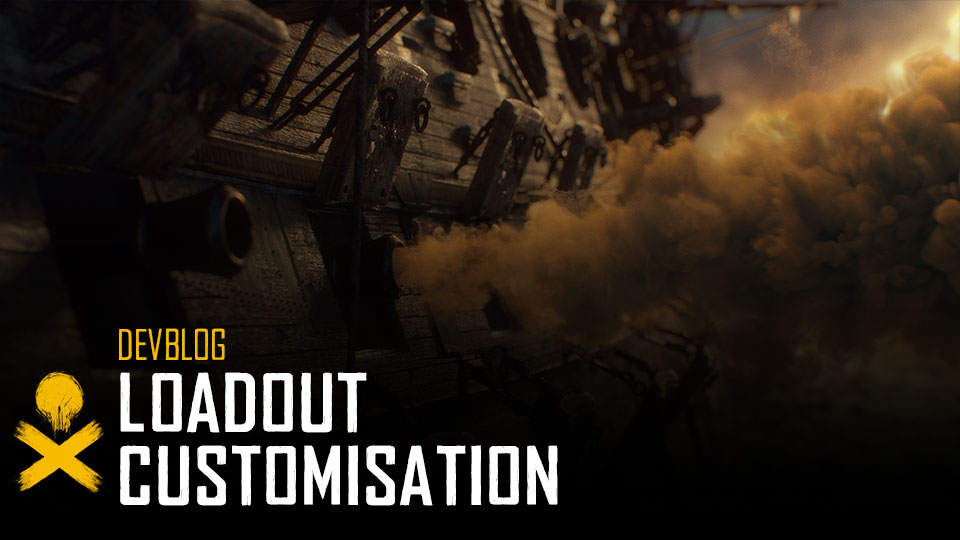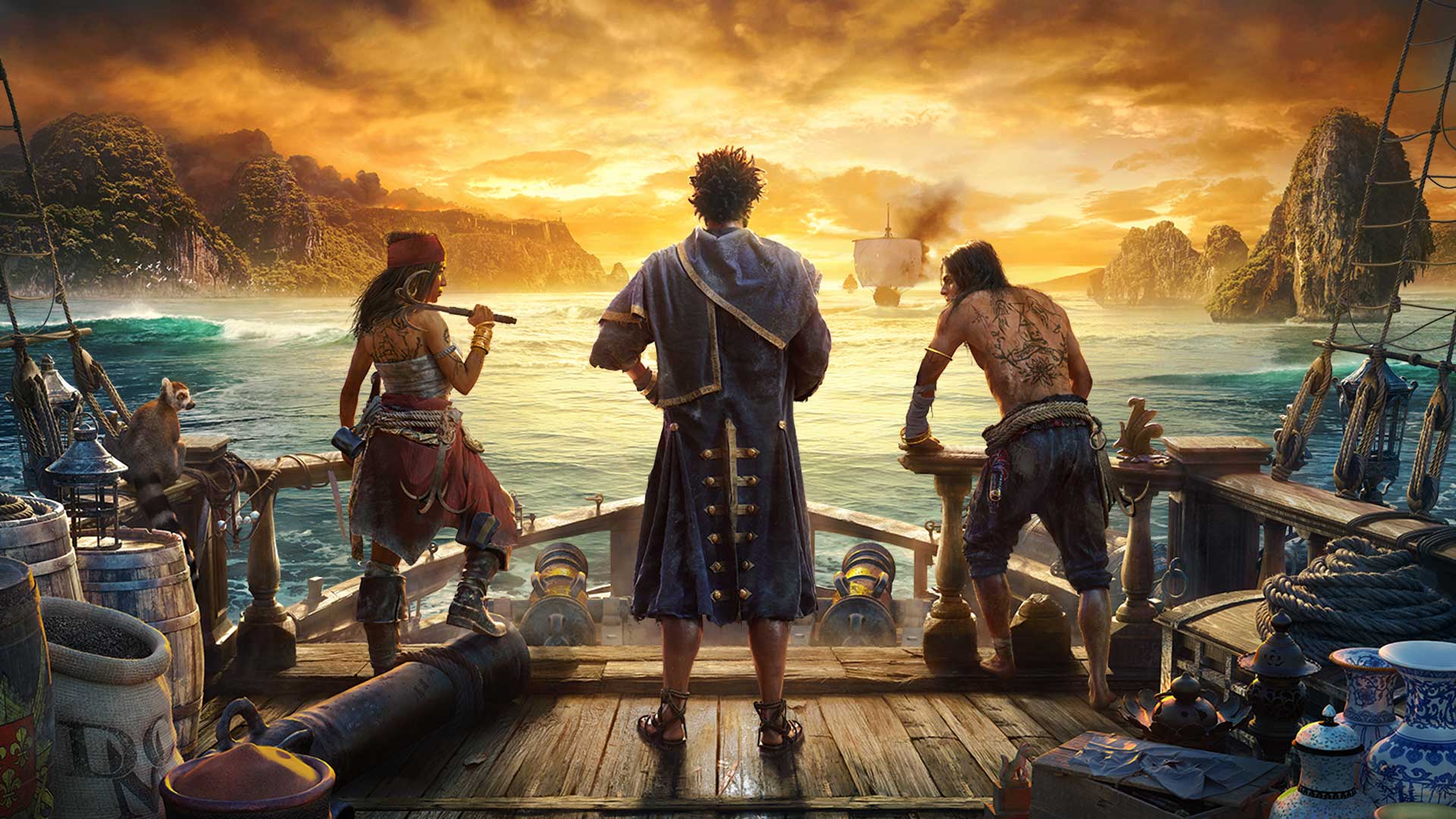Ahoy Captains!
We hope you enjoyed our livestream last Thursday and are excited to dive back into the world of Skull and Bones. In case you missed it, you can find the VOD right here. Make sure to give it a watch to see our trailers, Dev talks, and gameplay footage.
As we are ramping up to launch, we will be sharing a series of DevBlogs that will take you through all aspects of our game from combat to crafting to customisation and more. Let's dive in!
Disclaimer: As Skull and Bones is still in development some of this information may be subject to change.
Combat in Skull and Bones: Choosing your Loadout
Combat in Skull and Bones revolves around naval combat. Between pesky pirate hunters, hostile forts, and dangerous wildlife, you are sure to face many challenges on your journey to become the most fearsome pirate Kingpin to have sailed the seven seas. Luckily, you will have access to a wide variety of ships, weapons, and attachments that will help you on your way. Whether you are fighting ship-to-ship or plundering settlements and forts, having a well-thought-out loadout and strategy will be key in fighting your way to the top.
All ships, weapons, and attachments can be crafted by the Shipwright, Blacksmith, and Carpenter located in each den. All you need is the right blueprints and resources!
Choosing your Ship
Every captain needs a ship! In Skull and Bones you will get to choose from a wide array of different ships, each with different benefits and drawbacks. Each ship is dedicated to a specific role with a dedicated goal in mind.
Out of the many variables, size, category and perks are the main factors to consider when it comes to choosing the ship for your sail.
Size
The size affects hard physical and visual characteristic of a ship.
-
Draught profile : Decides how easily the ship can manoeuvre through rivers, near the coast or out onto the ocean. While bigger ships may be more appealing in general, they will navigate through rivers and lake with greater difficulties than smaller ships. On the other hand, smaller ships will find sailing through the open seas more challenging.
-
Weapon availability : The bigger the ship, the more weapons it can mount. Additionally, bigger, more spacious ships will be able to equip bigger weapons like the dreaded Giant Ballista or Greek Fire.
Perks
Each ship works as a frame which you can customise with furniture, weapons, and attachments. In addition, all ships are built with a unique perk which, when paired with the correct equipment, will help you optimise your loadout. Choosing wisely before sailing out will help design your own favourite playstyle, and maximise your ships and weapons abilities.
For example, the Hulk has a perk which increases its reload time and regenerate its brace strength faster while bracing. Paired with the right furniture and weapons, it may just play as the ideal tanker in a group. The Sloop on the other hand specialises in dealing fire and burning damage, quickly and effectively spreading chaos as flames catch nearby ships.
As you grow your reputation and explore the world you will unlock new ships with different stats and playstyles. It's up to you to decide what kind of captain you want to be!
Choosing your Weapons
Naval combat in Skull and Bones has a lot of variables to consider depending on your gameplay preferences or the activity requirements: range, damage, reload time, ammo consumption, ballistic trajectory, projectile travel time, area of damage, to only name a few.
You will thus need to carefully choose which weapons will play an important part in winning your skirmishes. Depending on your combat-style, you might want to favour some weapons above others. For example, demi-cannons have a faster rate of fire and will be deadly when used at close range but are not suited for long range engagements. A Giant Ballista takes time to aim and charge but will pack a deadly punch at long ranges.
Weapons are sorted into families, each representing a radically different gameplay style. Within each family are weapon variations, which further refine gameplay based on your needs and expectations. Let's have a closer look at a few of them now.
Cannons
This weapon family is the most portrayed representation of naval combat, both historically and in fantasy. They are dependable, have versatile variations catering for any need a captain could have. Most cannons are small enough to be fitted on ships inner decks, whereas some are top deck only.
They can be mounted on small or medium ships, bow, port, starboard or stern quadrants.
Here are a few examples you’ll be able to equip in game, each with several damage variants themselves:
-
Demi-Cannon: A short-range cannon that can be very powerful at close range but loses accuracy long range as its shots scatter.
-
Culverin: A versatile cannon with good range, damage and reload speed.
-
Long gun: A long-range precision weapon that might be slow to fire but packs quite a punch. Deals blunt or fire damage.
![[SnB] DevBlog - Loadout Customisation - NoText-Cannon-Asset](http://staticctf.ubisoft.com/J3yJr34U2pZ2Ieem48Dwy9uqj5PNUQTn/32hMmfLvUrHU1gh01u5KQY/dc95db763e3f1b4d4620780e20915421/NoText-Cannon-Asset.jpg)
Mortar
A long-range weapon that fires off projectile in a very high trajectory and inflicts area of effect damage to the aimed location, useful to hit multiple targets at once. However, the damage dealt will be reduced the further the target is from the centre of the blast zone.
Can be mounted on medium ships, only in the auxiliary slot.
As explained previously some weapons come with variants. For the mortar, some examples include, but are not limited to:
-
Burst Mortar: This massive artillery fires shrapnel-bearing shells. It is remarkable at ripping holes into hulls and causing ships to be Flooded
-
Repair Mortar: This Mortar has no damage capability. It instead delivers adhesives packs that expand on impact over a wide area, filling holes between the broken beams of friendly ships.
![[SnB] DevBlog - Loadout Customisation - NoText-Mortar-Asset](http://staticctf.ubisoft.com/J3yJr34U2pZ2Ieem48Dwy9uqj5PNUQTn/70cebOHwnBLw6brnaZ0cAb/07500ed7d25f3819a5b6004d23b1b718/NoText-Mortar-Asset.jpg)
Bombard
This weapon is a mix between a cannon and a mortar. It can be equipped on quadrants like cannons but fires off projectiles in a high trajectory that does area of effect to the aimed location like a mortar.
Can be mounted on small or medium ships, bow, port, starboard or stern quadrants.
Here are some Bombard variants, to give you a sneak peak of what you’ll find in-game:
-
Siege Bombard: This bombard shoots very dense and precise projectiles, dealing an extreme amount of damage in a reduced area. It is a very effective weapon against static targets. Deals piercing damage.
-
Fire Bombard: As its name suggests, it shoots incendiary shells that deal destructive damage around the impact zone and set targets ablaze.
-
Repair Bombard: Similar in effect to the Repair Mortar with a shorter range.
![[SnB] DevBlog - Loadout Customisation - NoText-Bombard-Asset](http://staticctf.ubisoft.com/J3yJr34U2pZ2Ieem48Dwy9uqj5PNUQTn/4FS593Tf3hvMr6Sl1lY3lh/4b950ea05a128e8477b407ea4526e7c5/NoText-Bombard-Asset.jpg)
Ballista
An oversized missile weapon that loads massive bolts on its charging mechanism. The longer the weapon is charged, the more damage, range and speed the projectile gains.
Can be mounted on medium ships, bow quadrant only.
Some examples include, but are not limited to:
-
Tearing Ballista: It launches giant bolts that are designed to rip sails apart
-
Twin Winch Ballista: This Ballista uses twin-winches for charged shots. They travel further than classic ones and deal more damage.
![[SnB] DevBlog - Loadout Customisation - NoText-Ballista-Asset](http://staticctf.ubisoft.com/J3yJr34U2pZ2Ieem48Dwy9uqj5PNUQTn/3gsUG6gJGf8kEFTpe4ETSo/71d9f75d61963b328decf5e1459ad986/NoText-Ballista-Asset.jpg)
Rockets
A short-range rack-mounted launcher which launches an unguided, rocket-propelled projectile.
Can be mounted on medium ships, auxiliary slot only.
Some of the rockets you will be able to use in-game:
- Siege Rocket: Designed by the Rempah, this variant delivers a barrage of fiery missiles that deal increased damage to structures like forts.
![[SnB] DevBlog - Loadout Customisation - NoText-Rocket-Asset](http://staticctf.ubisoft.com/J3yJr34U2pZ2Ieem48Dwy9uqj5PNUQTn/3EPnlUcZG7lv6o4MwtrCTz/1095df9d3f14962ff1b0eeed7022d2bf/NoText-Rocket-Asset.jpg)
Torpedoes
This weapon of stealth destruction unloads water-skimming projectiles that deal high damage on impact, but requires a long reload time. It is made for ship to ship naval combat, it cannot be used to target structures.Here are a some Torpedo variants, to give you a sneak peak of what you’ll find in-game:
- Explosive Torpedo : Fires high explosive torpedoes that can damage multiple targets, and deals double damage after being armed.
![[SnB] DevBlog - Loadout Customisation - NoText-Torpedo-Asset](http://staticctf.ubisoft.com/J3yJr34U2pZ2Ieem48Dwy9uqj5PNUQTn/2hV6rrpaVydcVCZ2UJfIst/c1e800725bbe540689b6198dde5292a3/NoText-Torpedo-Asset.jpg)
Sea Fire
A terrifying and highly accurate weapon that releases a torrent of flames at extreme short ranges, burning its target to a crisp. It is a high-risk, high-reward weapon.
![[SnB] DevBlog - Loadout Customisation - NoText-GreekFire-Asset](http://staticctf.ubisoft.com/J3yJr34U2pZ2Ieem48Dwy9uqj5PNUQTn/NI4HWaefsG9qUw4jhM3Aj/4a19c7e53bc1c05a88c6ae8389d5e3b8/NoText-GreekFire-Asset.jpg)
Attachments
Attachments are items such as armour that are placed externally on the ship. They do not take up any weapon slots when equipped and can provide valuable protection against incoming fire.
When choosing your attachments, it is important to consider what kind of situation you will be facing. If you’re expecting combat, it is wise to protect your ship by investing in different kinds of armour. As you rise in Infamy you’ll stumble on more specialised ones but here are the basics in terms of armours:
| Wood Armour | Protective wooden layer that offers resistance against flooding damage. |
| Metal Armour | Metal plate armour that is resistant against piercing damage. |
| Spiked Armour | Spiky armour that increases the ramming damage of your ship. |
| Leather Armour | Animal hides dipped in water that protects against fire damage. |
Furniture
In addition to attachments, your ship also has room for furniture which can provide valuable synergies for many gameplay styles. Not all ships have the same number of furniture slots, which is another factor to keep in mind when customising your playstyle.
Furniture are divided into major and minor furniture.
Major furniture can significantly alter your playstyle and can change the flow of combat, they are usually more unique, have significant power boosts, and more complex in nature. However, you can only equip one on each ship at any given time, so choose wisely.
Minor furniture offers small passive boosts for the player to augment their playstyle. It is usually easier to handle, and much less complicated to execute like a crew attack. Utility furniture on the other hand can help increase your cargo capacity, with navigation, or improve status effects. Investing in furniture will give you the edge you need to come up on top at combat or protect against harsh elements in the world of Skull and Bones.
Doing your research and knowing who and what you’re up against before heading into combat, could make the difference between life and death. Be sure to take your time to explore different combinations and synergies to create your perfect loadout. Over time you will also be able to upgrade your various weapons, attachments, and furniture which we will explore further in our DevBlog: Crafting Your Rise to Infamy. Should you still feel like you’re not quite ready to take on an enemy with your current setup, consider bringing along some trusty co-captains to support you in your endeavours!
Once you are happy with our loadout, it’s time to head out to sea and seek out your prey. We’ll be diving further into the combat of Skull and Bones in our DevBlog : Strategizing Your Attack, so stay tuned.
What will your loadout look like? Let us know in the comments below! And remember to follow us on Twitter, Facebook and Instagram to not miss any news!


